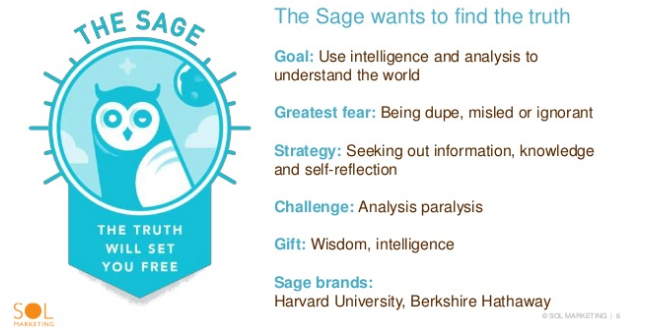The Definitive List of Brand Archetypes
We all want a loyal following. We’re constantly looking for that magical marketing plan that will connect us to our audience and make our product an irreplaceable part of their life. What we don’t often realize is that connections are relationships. If we aren’t clear about who we are, no one is going to be interested in dating us.
In my book Branding Is Sex, I’ve devoted an entire chapter to understanding who your brand is, and how you should be starting a relationship with your customers.
The short version is this: There are 12 basic identities—or archetypes—a brand can assume. Below I’ve broken down all 12 in extreme detail to help you understand where you belong.
1. The magician makes dreams come true
The magician archetype is all about vision. Magician brands don’t build you a better toothbrush or help you keep your house clean, they bring your wildest dreams to life.
What they offer is a grand experience no one else could achieve. A magician is so in tune with the fundamentals of the universe that they can create the impossible.
Disney is the perfect magician. Disney is fundamentally a media company, but they are unlike any other.
Quick—think of the books and videos that have helped you in your career. You’re probably thinking of titles targeted to your industry, full of actionable advice and guidance.
Disney doesn’t do any of that. What they offer is a transformative experience.
They are in a category of their own because of the grandness of their vision. Imagine another brand that could build a “Magic Kingdom” or a “Disney World.”
2. The sage is always seeking the truth
To a sage, wisdom is the key to success. Everything else is secondary to the pursuit of knowledge.
A sage brand might not feel warm and cuddly. They don’t enrapture you in a fantastic world like Disney. Instead, a sage commands your respect by showing their brilliance.
Harvard University is one of the most revered universities in the world. Boasting an alumni list that includes eight US presidents, 21 Nobel laureates, and Mark Zuckerberg (sort of), Harvard’s brand is all about being the smartest.
Take this video for example. It’s not about success in life or fantasy, it’s about the power of knowledge. The video says the secrets of the universe hide in books, and that Harvard is where they are studied.
3. The innocent just wants to be happy
The innocent belongs in paradise. Everyone is free, virtuous, and happy in an innocent’s world.
An innocent brand will never guilt you with an ad or go over the top to convince you. Instead, an innocent brand will charm you with something much more powerful: Nostalgia.
Orville Redenbacher is the prototypical innocent archetype.
[source: Hammer and Rails]
What adult do you know who is that happy about their suspenders? What adult do you know that even owns suspenders?
But that’s Orville’s appeal. They sell you a childhood treat, popcorn, and their mascot is a grandpa who hasn’t stopped having fun since bowties were a thing unironically.
Nothing heavy-handed, just happiness.
4. The outlaw wants revolution
The outlaw isn’t afraid. Outlaw brands control their own life without regard for the status quo.
Where the innocent archetype touches the part of you that loved snack time in kindergarten, the outlaw archetype appeals to the part of you that cut classes in high school.
Building a cult following like Apple is the ultimate goal of an outlaw brand.
Remember those old iPod commercials where monochrome people had the best times of their lives dancing?
[source: Cult of Macs]
That ad doesn’t tell you to stand in a crowd or go to a concert. It tells you to be yourself, to dance whenever you like, and to do it with Apple.
If you think Apple doesn’t have a cult following, consider this. Did people wait in line for hours when the Galaxy S7 was released? No, is the answer.
5. The jester lives in the moment
The jester is all about having fun. Jester brands might not be curing illnesses, but they’re making your day better.
Humor, silliness, even nonsense are all in a jester’s toolkit. The goal of a jester brand is to make you smile with light-hearted fun.
The Old Spice Man is one of our all-time favorite ad campaigns, and the perfect example of a jester archetype.
[source: ePharmacy]
Some guys react well to hyper-masculine branding. Other guys don’t. By making a joke out of these super manly brands, Old Spice gets to appeal to both sides.
Guys who are into overly masculine brands get to be in on the joke. Guys who aren’t into macho brands get to laugh at them.
Everybody laughs, and everybody likes Old Spice as a result.
6. The lover wants to make you theirs
Passion, pleasure, and sensuality are the lover’s keywords. A lover brand wants you to associate them with intimate moments in your life.
What do you buy to celebrate? What do you buy your significant other for birthdays and anniversaries? Chances are, you’re buying from a lover brand.
Think of Godiva Chocolate ads. Do they ever make you think about your health, your finances, or your future?
No. Godiva seduces you. It shows off its richness and creaminess. It invites you to take part in life’s greatest indulgence: Chocolate.
7. The explorer wants to break free
Freedom is all an explorer cares about. Where other brands might try to help you build a home, explorer brands want to get you outside.
With this in mind, it makes sense that many outdoor brands are natural fits for the explorer archetype.
Subaru is the classic explorer brand. They don’t sell their cars based on luxury or comfort, they stress the freedom a Subaru provides.
[source: Tutsplus]
Blizzard? No problem. Subaru lets you decide where you’re going, no matter the circumstance. You’re free.
8. The ruler wants absolute power
Luxury and exclusivity are what the ruler is all about. A ruler brand is a gatekeeper. If a customer buys from them, they get to belong to the elite.
Being perceived as high-quality and expensive is critical for a ruler brand. Jewelry and high-end vehicles are natural fits for the ruler archetype.
Do you buy a Mercedes Benz because of its crash test rating? What about its gas mileage? Its heated seats?
No. You buy a Mercedes Benz because you can afford to, and most other people can’t. Whenever you park your car, people will understand your status without you saying a word.
That quietly understood value is what a ruler brand sells.
9. The caregiver wants to nurture you
The caregiver is benevolent. They want to be there for you and the people you love.
Caregiver brands are all about warmth and trust. You can depend on them when it comes to your children. It’s rare to see a caregiver brand run an ad that takes a shot at their competition. They are the opposite of confrontational.
Johnson & Johnson’s tagline line is “Johnson & Johnson: A Family Company.” You can’t get more committed to families than that.
[source: Johnson & Johnson]
A Johnson & Johnson ad always focuses on how their products help you take care of your children. How their products build families. This is bread-and-butter for the caregiver archetype.
A caregiver is all about instilling trust between in the customer that for the rest of their life, the brand will be there for them.
10. The hero wants to prove himself
The hero makes the world better by being the best. A hero brand isn’t concerned with nurturing you, they’re interested in challenging you.
If you want to rise to the occasion, you’re going to need a hero’s help.
The U.S. Army is the ultimate example of a hero archetype.
Think of the recruitment commercials you’ve seen with troops jumping out of helicopters, running through training courses, and protecting the country. Any of that resemble your day-to-day?
Of course not. It’s not supposed to. It’s designed to compel you to “answer the call” and rise to the occasion by joining with a hero brand: The U.S. Army.
11. The regular guy/girl wants to belong
No glitz or glamour, just a reliable product that gets the job done. That’s what regular guy/girl brands are selling.
The archetype is focused on providing something so far removed from pretentiousness that it can appeal to everyone. It is the hardest archetype to pull off, because you have to have a product that actually appeals across demographics.
Everyone drinks coffee. Not every individual person, but every major demographic with the possible exception of infants. That’s what makes Folgers a great every guy/girl brand.
Folgers doesn’t market to a hip crowd. They don’t brag about their high quality, all-organic coffee. They keep it simple: “The best part of waking up is Folgers in your cup.”
Everyone wakes up. Everyone drinks Folgers.
12. The creator craves perfection
A creator isn’t worried about the cost of production or making things at scale. They care about one thing: building the perfect product.
While the magician also stresses vision and imagination, creators are different in that they don’t unlock the world’s magic and create the impossible. They create the perfect product.
Lego is a great example of a creator archetype. Take a look at this ad for Lego Vision:
[source: Ads of the World]
Lego recreated in stunning detail the most famous sights of the world. They didn’t build new sites, and they didn’t create some new technology that put the sites in your home.
Lego used the simplest technology possible: blocks. They took this simplicity and pushed it to its most perfectionist extreme. That’s what being a creator is all about.
What archetype is your brand?
This is one of the key questions we help clients answer at Sol Marketing. Almost every client comes to the table assuming they are the every guy/girl, but in 99% of cases, they aren’t.
Drilling down into what makes your brand special and how your customers best connect with your products isn’t easy, but it’s the most important thing you can do to understand what archetype you should be using.
The ideas in this post were inspired byCarol Pearson’s The Hero and the Outlaw: Building Extraordinary Brands Through the Power of Archetypes.



















